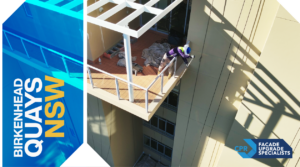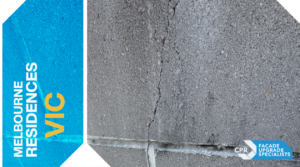Recognising the Early Signs of Facade Rust in Coastal Australia Coastal buildings in New South Wales face a unique set of environmental challenges. One of the most serious is corrosion—particularly rust forming on building facades. Identifying facade rust spots and corrosion risks in coastal NSW is critical to preventing structural damage, safety hazards, and costly repairs.
In this article, we explore how to detect facade rust spots, assess corrosion risks, and take proactive steps to protect coastal assets. We’ll also highlight how CPR Facade Upgrade Specialists use proprietary Scaffold-Free™ technology to deliver corrosion control, without disrupting daily building operations.
Why Rust Forms on Building Facades in NSW’s Coastal Zones
The combination of high humidity, airborne salt particles, and wind-driven rain accelerates the deterioration of exterior materials. Salt air corrosion aggressively attacks metal components embedded within or attached to the facade—especially fixings, lintels, balustrades, and reinforcement bars hidden within concrete structures.
Common causes of corrosion in NSW coastal buildings:
- Salt air exposure: Moisture and chloride ions break down protective coatings.
- Poor facade detailing: Inadequate drainage or flashing allows water ingress.
- Substandard materials: Some metals lack sufficient anti-corrosive treatment.
- Weathering and UV degradation: Paints and sealants degrade over time, exposing substrates.
Key Areas to Inspect for Facade Rust Spots
Effective corrosion identification starts with a comprehensive facade inspection. Key areas vulnerable to rust damage include:
- Balconies and handrails (metal fixtures)
- Parapets and rooflines with exposed fixings
- Expansion joints and corners where sealants fail
- Reinforced concrete edges (spalling may expose rusted rebar)
- Window frames and shading devices (metal supports)
Signs of Rust and Corrosion to Watch For
Property owners and strata committees should regularly look for visual indicators of corrosion, including:
- Brown-red staining streaks on surfaces
- Cracking, bubbling, or flaking paint
- Concrete cracking and spalling (indicating rusting steel beneath)
- Surface pitting or delamination on metal parts
- Dampness or leaks near joint lines or flashings
Conducting a Professional Corrosion Risk Assessment in NSW
Corrosion risk assessment in NSW must be tailored to site-specific conditions. CPR conducts facade inspections using SFS360®—a rope-access diagnostic system that segments the entire building envelope into a repair map. This allows:
- Precise identification of facade rust spots
- Quantification of corrosion severity
- Photographic records of each drop, level, and patch
- Condition reports and recommended rust prevention or remediation plans
Understanding the Lifecycle of Coastal Facade Corrosion
Left untreated, rust on building facades follows a predictable and destructive cycle:
- Minor paint degradation or sealant failure
- Water ingress and oxidation of metal elements
- Expansion of rust causes cracking and spalling
- Accelerated deterioration and safety concerns
Early intervention with corrosion protection for facades can interrupt this cycle and significantly extend the life of building exteriors.
Preventing Rust Damage in Coastal Buildings
CPR recommends a multi-step rust prevention strategy:
- Use of rust-resistant building materials such as stainless steel or aluminium where appropriate
- Protective coatings like anti-corrosive primers, sealants and membrane coatings (see Paint & Protective Coatings)
- Scheduled facade maintenance plans tailored to coastal exposure
- Immediate treatment of detected rust spots to prevent spread
- Comprehensive facade inspections every 2–3 years in high-risk zones
Facade Remediation Techniques for Coastal NSW
If rust is already visible or damage has progressed, CPR offers specialist remediation services, including:
- Rust removal and metal surface treatment
- Recoating with marine-grade protective systems
- Concrete spalling repair and rebar passivation
- Full repainting and waterproofing
- Sealant and joint replacement
All works are delivered using CPR’s Scaffold-Free™ approach with MARS™ rope access and SkyPod® workstations—ensuring minimal disruption to occupants and surroundings.
Why Choose CPR for Your NSW Facade Inspection and Remediation
CPR is the only provider in Australia offering an end-to-end solution for high-rise and difficult-access facade upgrades. Our approach combines:
- Expert Consultancy using ASP’s™ and SFS360®
- Seamless Project Management with SE2EPC®
- Long-term asset care through our AfterCare™ service
- Exclusive access to SkyPod®, PEARS®, MARS™ and Upseiling® technologies
Our corrosion control solutions are designed specifically for:
- Strata buildings on the NSW coast
- Government and institutional facilities
- Heritage and ageing commercial structures
- High-rise towers with no scaffolding feasibility
Next Steps: Book a Corrosion Inspection Today
Don’t wait for rust to compromise the safety or value of your property. Book a corrosion risk assessment with CPR’s facade consultants and protect your investment from salt air corrosion and structural degradation.
Learn more: Facade Remediation & Preservation Services






